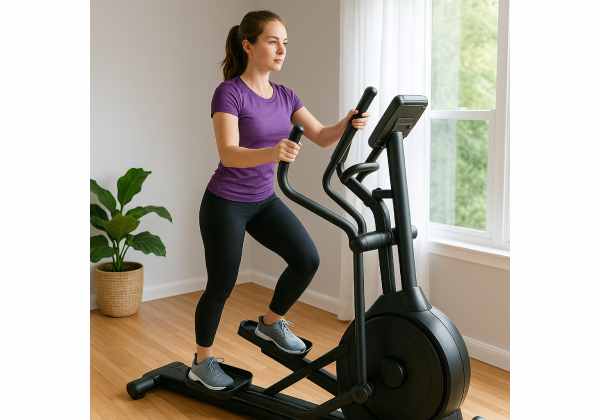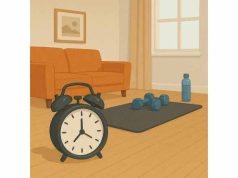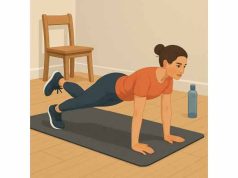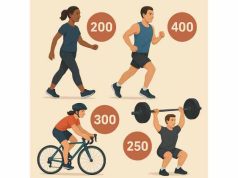
The elliptical is a practical tool for fat loss. It is joint-friendly, easy to learn, and simple to progress. With the right structure—clear intensities, short intervals, and steady aerobic work—you can raise weekly energy use without the soreness that derails consistency. This guide shows you how to set the machine for your body, select interval formats that match your fitness, and follow an eight-week progression. You will also find technique cues, fueling advice, and troubleshooting tips so each session moves you toward a measurable result. For the bigger picture that combines strength, cardio, and steps into a workable plan, start with our overview of exercise methods for losing fat and then return here to put your elliptical program into action.
Table of Contents
- Do ellipticals burn fat?
- Setup, technique and intensity
- Low-impact interval templates
- Progression: first 8 weeks
- Form cues and common mistakes
- Joint-friendly tweaks
- Fueling, recovery and tracking
- Frequently Asked Questions
Do ellipticals burn fat?
Yes—when sessions are consistent and paired with a modest calorie deficit. An elliptical workout increases your exercise activity (EAT), but it also helps by improving fitness so you can do more total weekly movement. Because the motion is low-impact, you can repeat it often without the recovery cost of high-impact running. That repeatability is valuable for weight loss.
What to expect from typical sessions
Calorie estimates vary with body size, resistance, cadence, and fan or room temperature. As a rough range:
- Easy–moderate 30 minutes: ~150–250 kcal
- Vigorous 30 minutes: ~220–330+ kcal
- Intervals 20–25 minutes: similar totals to vigorous steady efforts, with higher perceived exertion and strong fitness return
Treat these as bands, not promises. Use them to plan, then judge progress by performance, waist measures, and weekly average weight rather than single-day watch readouts.
Why the elliptical suits a fat-loss phase
- Low orthopedic stress. Less joint pounding allows more weekly minutes.
- Scalable intensity. Resistance and incline let you move from easy aerobic work to demanding intervals on the same machine.
- Whole-body involvement. Handles add upper-body contribution and help posture.
- Access and safety. No traffic, weather, or need for specialized technique to begin.
How often should you use it?
Most adults do well with 3–4 sessions per week: one interval day, one tempo/moderate day, and one to two easy aerobic sessions. Pair these with two short strength workouts to protect muscle while the scale moves. For a concise refresher on pacing loss, portion anchors, and expectations, review our guide to healthy weight-loss basics.
Big picture
Training decides what you keep—primarily muscle and cardiovascular fitness. Nutrition determines net fat loss. Aim for steady adherence rather than spikes of effort. The sections that follow translate that principle into settings, intervals, and week-by-week progressions.
Setup, technique and intensity
Proper setup makes sessions more effective and more comfortable. Take two minutes at the start of your ride to dial in positioning and a clear intensity target.
Machine setup
- Foot placement: center your feet; keep weight balanced across heel and midfoot to avoid calf overuse and foot numbness.
- Stride length: if adjustable, choose a natural mid-range that lets you keep hips level and knees tracking over the feet.
- Handle choice: using moving handles increases total muscle involvement and keeps posture tall; fixed handles are useful for high-resistance climbs or when you need stability.
Posture cues
- Tall chest, relaxed shoulders, eyes forward.
- “Ribs down, zipper up”—a light brace that supports breathing.
- Drive through the full foot; avoid tip-toeing.
- Let the arms push and pull lightly rather than leaning bodyweight onto the handles.
Cadence and resistance
Most machines display strides per minute (SPM) or cadence. As a guide:
- Easy aerobic: 120–135 SPM with light-moderate resistance
- Moderate/tempo: 135–150 SPM with moderate resistance
- Hard intervals: 150–165 SPM with moderate-high resistance (briefly)
If your model uses incline, start with 0–3% for easy work, 4–8% for moderate climbs, and 8–12% for short interval blocks. Match resistance and incline so cadence stays smooth.
Choosing intensity
Use one or more of these tools:
- RPE (rate of perceived exertion):
- Easy conversational = RPE 4–5/10
- “Comfortably hard” = RPE 6–7/10
- Clearly hard work intervals = RPE 8–9/10
- Heart rate: anchor easy days near Zone 2; harder efforts move into Zones 3–4. For a plain-English explainer of easy aerobic work and why it matters, see intro to Zone 2 training.
- Talk test: you can speak in full sentences at easy; short phrases at tempo; single words during the final seconds of a hard interval.
Warm-up and cool-down
Spend 5–8 minutes ramping from easy to moderate. Include two 10–15 second pickups to rehearsal pace. Cool down for 3–5 minutes at low resistance to normalize breathing and heart rate.
Safety notes
- Avoid holding the top of the console; it rounds the back and reduces leg contribution.
- Heat increases perceived effort indoors; use a fan and hydrate.
- If you feel knee discomfort, lower incline slightly, keep cadence smooth, and check that the knees track over the feet rather than collapsing inward.
Low-impact interval templates
Intervals on an elliptical deliver a strong fitness return without impact. Choose a template that fits your current level and time window. Increase only one variable per week (reps, interval length, or resistance).
10–12 minutes (when time is tight)
- Format: 30″ hard / 30″ easy × 10–12 rounds
- Targets: hard at RPE 8/10, 150–160 SPM; easy at RPE 4/10, 120–130 SPM
- Progression: add two rounds or a small resistance bump once you complete 12 rounds cleanly.
20 minutes (beginner-friendly HIIT)
- Format: 1′ hard / 1′ easy × 10
- Targets: keep cadence smooth; avoid mashing heavy resistance that ruins posture.
- Progression: move to 1:1.5 (60″ hard / 90″ easy) for cleaner efforts if form slips.
For more quick options that slot into busy days, see our concise 20-minute workout ideas.
25–30 minutes (tempo + surges)
- Format: 5′ steady tempo (RPE 6–7/10) + 30″ strong / 30″ easy × 6, repeat the block once.
- Targets: keep heart rate controlled during tempo; surges push effort without form breakdown.
- Progression: add 1–2 surge rounds per block up to 8 each.
30 minutes (3:2 build)
- Format: 4×[3′ strong / 2′ easy] after a 6′ warm-up; 4′ cool-down.
- Targets: strong segments sit just below threshold—talk in short phrases.
- Progression: make the strong segments 3:30–4:00 over several weeks.
Hills emphasis (joint-friendly climbing)
- Format: incline 8–10% for 90″ hard / 90″ easy × 8–10, resistance moderate, cadence 140–150 SPM.
- Cue: keep heels in contact; imagine “stepping through” the whole foot.
Steady aerobic alternatives (recovery or base)
- 20–45 minutes continuous at RPE 4–5/10, cadence 120–140 SPM, light-moderate resistance.
- Progression: add 5 minutes every 1–2 weeks until you reach your time target.
Finisher option (3–5 minutes)
- Ladder: 20″ hard / 20″ easy, 30″/30″, 40″/40″, then back down. Keep posture crisp.
General rule: end every session feeling you could complete one more interval with good form. That repeatability preserves consistency across the week.
Progression: first 8 weeks
Progress slowly and predictably. The plan below balances aerobic work, intervals, and recovery. Each “workout” includes warm-up and cool-down.
Intensity key
- Easy aerobic = RPE 4–5/10
- Tempo/steady strong = RPE 6–7/10
- Hard intervals = RPE 8–9/10 (briefly)
Weeks 1–2
- Mon: 20–25′ aerobic continuous
- Wed: 1′ hard / 1′ easy × 8–10
- Sat: 25–30′ tempo + surges (5′ steady + 30″/30″ × 6; repeat once)
Weeks 3–4
- Mon: 25–35′ aerobic (add 5′ if you feel fresh)
- Wed: 1′ hard / 1′ easy × 10–12 or 3′ strong / 2′ easy × 4
- Sat: hills emphasis 90″/90″ × 8–10
Weeks 5–6
- Mon: 30–40′ aerobic with a short cadence drill (4×1′ at 100–110 rpm equivalent, easy between)
- Wed: 3′ strong / 2′ easy × 5–6
- Sat: tempo block 2×10–12′ with 3–4′ easy between
Week 7 (deload)**
- Reduce total time and reps by ~30%. Keep frequency. Focus on easy aerobic and technique.
Week 8 (retest and refresh)** Choose a repeatable 20-minute steady best and note cadence, heart rate, and perceived effort. Retest one interval format (e.g., 1:1) and compare average cadence at a similar RPE. Strength and rest days
Place two short strength sessions (30–40 minutes) on non-consecutive days. Keep at least one true rest day weekly. For help spacing intensity and recovery, see our guide on planning rest days. Progressive knobs (change one at a time) Add one interval per session (up to the upper ranges above). Extend the tempo block by 1–2 minutes. Nudge resistance slightly while maintaining cadence. Add 5 minutes to the aerobic day every 1–2 weeks. Back to top ↑ Form cues and common mistakes Good technique protects joints and improves output at every resistance level. Use this short checklist. Keep these cues in mind Tall posture: ears over shoulders, shoulders over hips. Neutral ribcage: gentle brace so the lower back does not sway. Full foot drive: press through heel-to-midfoot; avoid bouncing on the toes. Active arms: light push–pull to steady the torso; do not overgrip. Frequent errors—and fixes Leaning on the console: reduces leg contribution and stresses wrists. Fix: hold moving handles or hover your hands lightly. Overstriding: excessive reach can tug hips and knees. Fix: pick a stride length that allows smooth turnover at your target cadence. Too much resistance too soon: cadence collapses and form degrades. Fix: choose a resistance that lets you hold technique and breathing. Monotony: repeating one pace stalls adaptation. Fix: rotate aerobic, tempo, and interval days. Warm-up and mobility
Always include a short ramp from easy to moderate before harder work, and finish with a cool-down and a few gentle hip and calf stretches. If you want a simple five-minute sequence that primes posture and ankles, browse our quick guide to warm-up and recovery basics. Foot numbness tips
Loosen shoes slightly, shift weight through the whole foot, and add brief posture checks every few minutes. If your model allows, vary incline to change joint angles during longer rides. Back to top ↑ Joint-friendly tweaks The elliptical is already low-impact, but small adjustments improve comfort when knees, hips, or backs are sensitive. If knees complain Lower incline slightly and maintain cadence; avoid grinding at very low turnover. Keep knees tracking over the midfoot; prevent inward collapse by engaging glutes. Shorten stride a notch if your model allows. If hips or low back feel tight Choose a mid-range stride length rather than maximum. Keep ribcage gently down and avoid leaning heavily on the handles. Insert short standing posture resets every 3–5 minutes. For larger bodies or beginners Start with 10–15 minute blocks at RPE 4–5/10; add time by 2–5 minutes weekly. Use intervals with longer easy periods (e.g., 30″ hard / 60–90″ easy) to practice smooth effort changes. During flare-ups Swap hard intervals for easy aerobic sessions until symptoms quiet. Emphasize cadence and posture.
For more ideas on joint-friendly cardio choices and substitutions, see our overview of low-impact options for sensitive knees. Pregnancy and postpartum Prioritize comfort and breath control; avoid breath holding. Keep intensities moderate unless cleared individually. Stop any session that provokes pelvic pain, dizziness, or unusual symptoms and consult a clinician. Back to top ↑ Fueling, recovery and tracking You will lose fat by aligning training with a sustained, modest calorie deficit and practical recovery habits. Fuel enough to train well; keep weekly intake slightly lower than expenditure. Before sessions Easy ≤60 minutes: water; a recent meal within 2–3 hours usually suffices. Intervals or longer sessions: small carb + protein 60–90 minutes before (e.g., yogurt and fruit; toast and eggs). During ≤60 minutes: water; optional electrolytes if you sweat heavily. >60 minutes or very warm rooms: 20–40 g carbs per hour plus fluids with sodium. After A balanced meal within 1–2 hours: protein (roughly 20–40 g for many adults), fiber-rich carbs, and fluids. Avoid oversized “rewards” that erase your deficit. Sleep and stress Target 7–9 hours. Poor sleep increases hunger and reduces training quality. Keep at least one true rest day each week; deload every 4–6 weeks by trimming volume ~30%. Tracking what matters Performance: average cadence or resistance for your key interval formats; time to fatigue at a set RPE; heart-rate drift during steady rides. Body measures: weekly average weight (3 morning weigh-ins), waist/hip every two weeks, monthly photos. Behavior: sessions completed, minutes moved, and step counts. If progress stalls (change one variable) Add one interval or 5 minutes to an aerobic day. Slightly increase resistance while maintaining cadence. Trim ~200 kcals/day from calorie-dense extras; keep protein stable. Add 1,500–2,500 steps/day for two weeks. Insert a deload week, then rebuild. Back to top ↑ Frequently Asked Questions Is the elliptical good for losing belly fat? The elliptical helps you lose body fat overall by increasing weekly energy use, but it does not spot-reduce fat from the abdomen. Definition at the waist improves as overall fat decreases. Combine consistent training with a modest, sustainable calorie deficit for visible change. How many minutes should I do on the elliptical to lose weight? Most people progress well with 25–45 minutes per session, three to four days per week, blending easy aerobic rides, tempo segments, and short intervals. Start at the low end and add five minutes or one interval at a time as fitness and recovery allow. What resistance and incline are best for fat loss? Choose resistance and incline that let you hold smooth cadence and posture at the target intensity. For easy rides, use light-moderate settings; for intervals, increase resistance or incline briefly without grinding. The best setting is the one you can repeat consistently. Elliptical or treadmill: which burns more? Per minute, results overlap. Treadmills often feel harder due to impact and may show higher heart rate at the same perceived effort. Ellipticals reduce impact and are easier to repeat frequently. Choose the option that protects joints and fits your schedule; consistency wins. Can I use the elliptical every day? Daily easy spins are fine for many, but limit hard intervals to 2–3 sessions per week. Keep at least one true rest day and monitor fatigue, sleep, and mood. If quality drops, reduce volume or intensity and add recovery. Do I need to use the moving handles? Handles promote a taller posture and light upper-body involvement, which many find helpful. For steep or high-resistance efforts, switching to fixed handles can steady your trunk. Alternate based on comfort and the goal of the session. Back to top ↑ References WHO guidelines on physical activity and sedentary behaviour 2020 (Guideline) Overweight and obesity management 2025 (Guideline) Effect of High-Intensity Interval Training vs. Moderate-Intensity Continuous Training on Fat Loss and Cardiorespiratory Fitness in the Young and Middle-Aged a Systematic Review and Meta-Analysis 2023 (Systematic Review) Impact of different physical activity types on knee joint structural degeneration assessed with 3-T MRI in overweight and obese subjects: data from the osteoarthritis initiative 2021 (Observational Study) Application and Measurement Properties of the Talk Test in Individuals with Cardiopulmonary Diseases: A Systematic Review 2022 (Systematic Review) Medical Disclaimer This article is educational and does not replace personalized medical advice. Consult a qualified professional before changing your exercise or nutrition plan, especially if you have cardiovascular, metabolic, or orthopedic conditions; take medications that affect heart rate or balance; are pregnant or postpartum; or are returning after injury or surgery. Share and Stay Connected If this guide was useful, consider sharing it and follow us on your preferred platform. Your support helps us continue producing clear, evidence-informed fitness resources.










